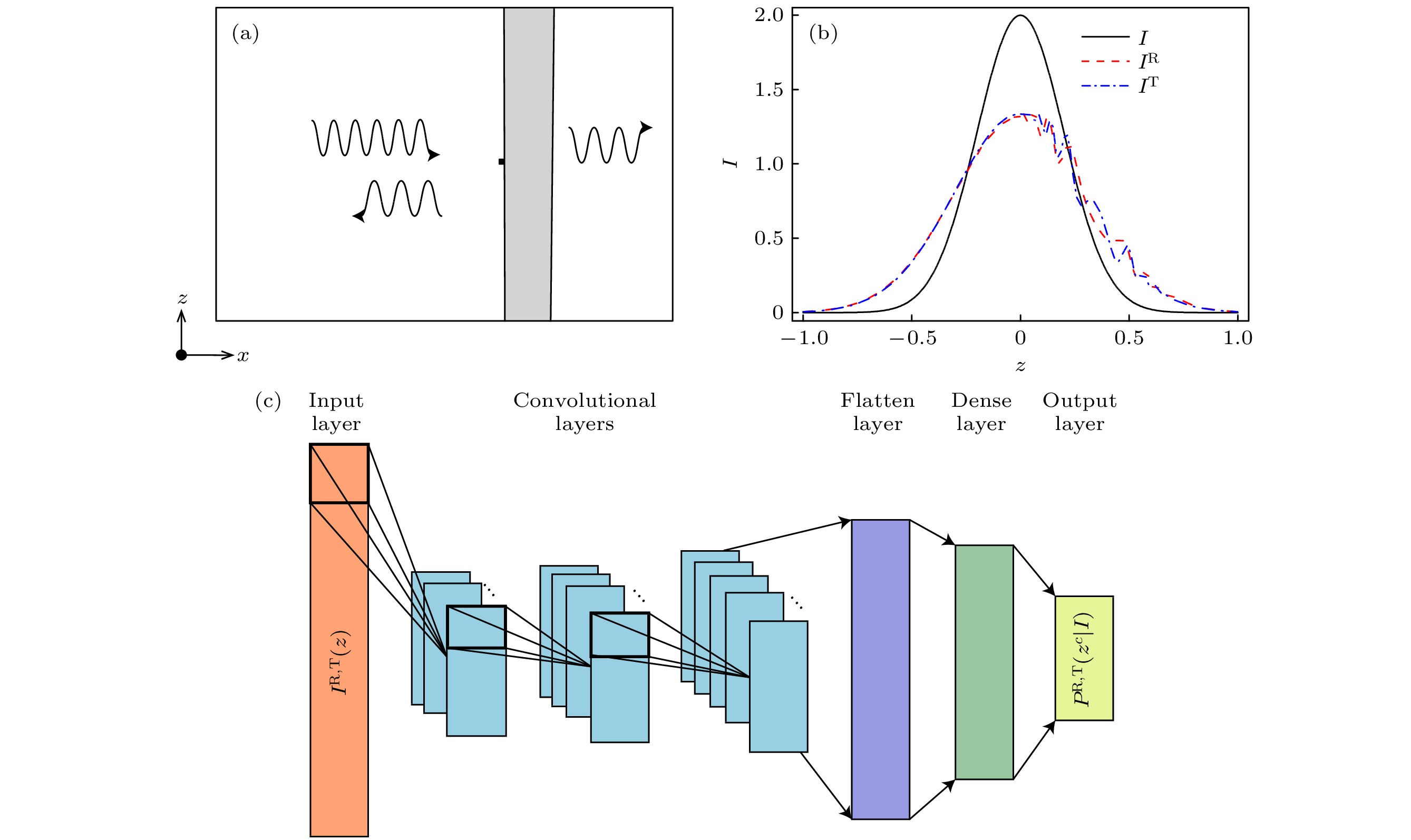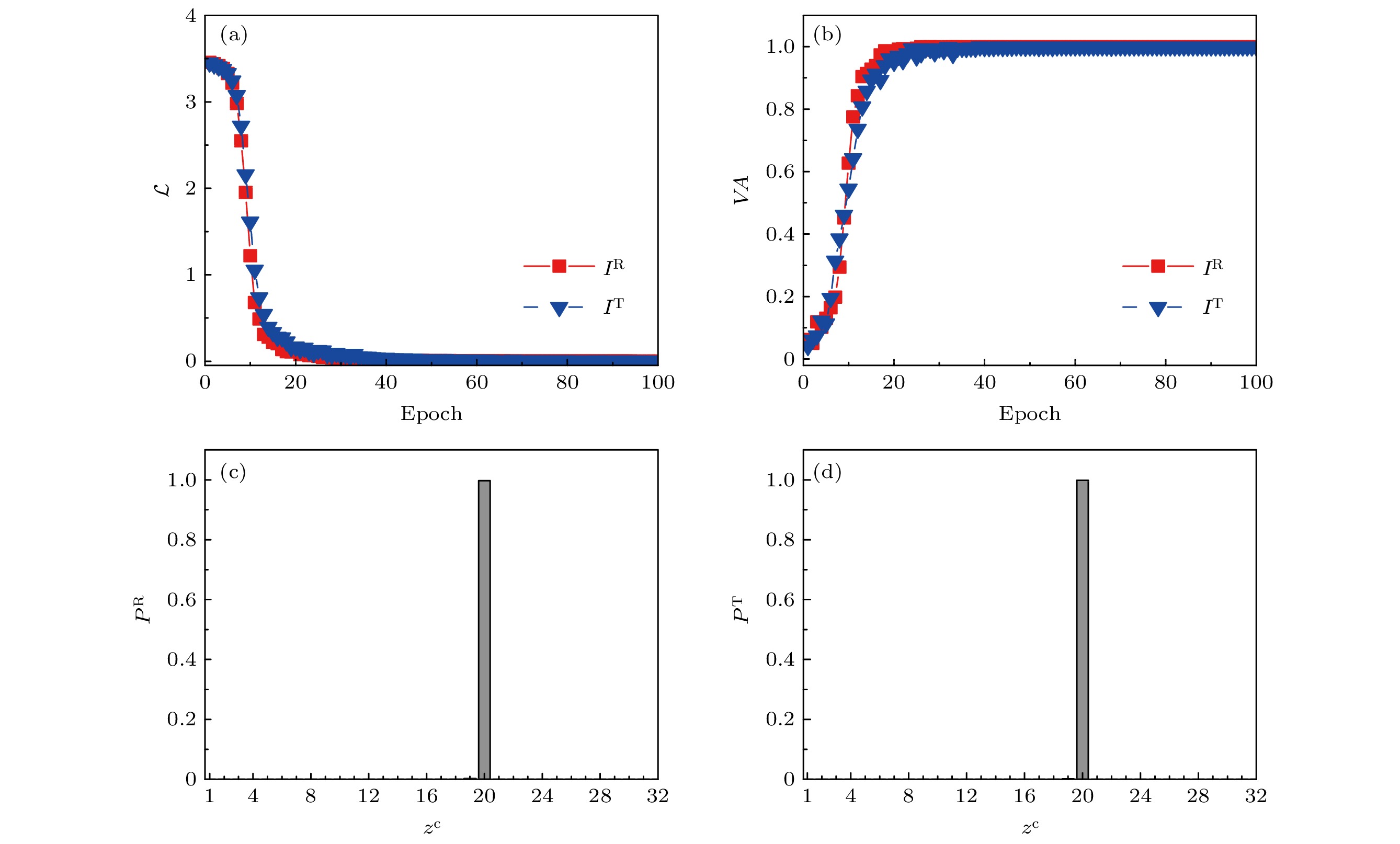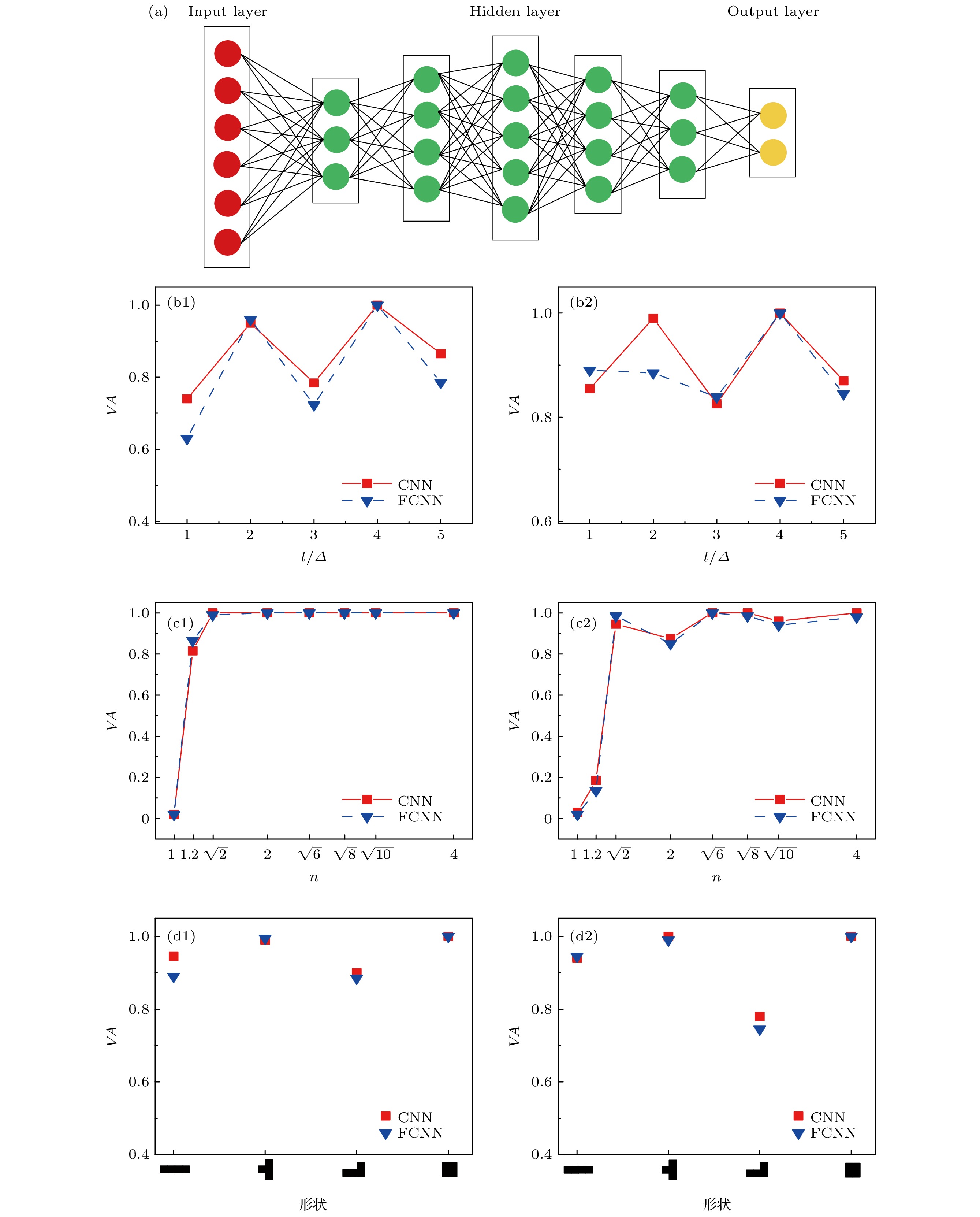-
在基于激光技术的现代光学实验和光学应用中, 光学元器件表面的微杂质和微缺陷是影响光学系统精密程度的主要因素之一, 因而光学表面杂质和缺陷的定位检测是一个重要的问题. 本文提出利用深度神经网络来辅助光学杂质检测的理论方案. 模拟了一束探测激光脉冲照射到具有单个微小杂质的光学表面时, 反射信号和透射信号中所携带杂质的位置信息可被一个深度卷积神经网络学习并定位. 此外, 通过改变杂质大小、折射率等属性生成了一系列泛化数据集, 并讨论了神经网络在泛化数据集上的表现. 泛化结果表明, 神经网络对杂质位置的预测能力具有较高的鲁棒性. 最后, 还对比了卷积神经网络和全连接神经网络这两种不同架构网络的学习能力.Laser technology plays fundamental roles in the modern optical experiments and applications. The performance of optical devices will be significantly affected by micro impurities and defects on the optical surfaces. Therefore, precisely positioning the optical impurities and defects is an important issue in optics. In this paper, we theoretically propose to adopt the deep learning neural networks in addressing this problem. Specifically, we generate the training data via simulating the dynamic process in which a probe optical pulse being scattered by a micro-impurity on an optical surface, and then the position information of the impurity carried by the reflection and the transmission signal can be efficiently learned by a deep convolutional neural network. One step further, we show that the deep neural network can make precise predictions on the generalization datasets generated through varying the size, refractive index, and geometry of the impurity, respectively. Additionally, we also compared the learning capability of two different networks architectures. This work provides new perspective for the impurity and defect detections in the field of precision optics.
-
Keywords:
- optical impurity detection /
- machine learning /
- neural network /
- deep learning
[1] Gyongyosi L, Imre S 2019 Comput. Sci. Rev. 31 51
 Google Scholar
Google Scholar
[2] Williams C P 2010 Explorations in Quantum Computing (London: Springer Science and Business Media) p3
[3] Bruzewicz C D, Chiaverini J, McConnell R, Sage J M 2019 Appl. Phys. Rev. 6 021314
 Google Scholar
Google Scholar
[4] Gisin N, Thew R 2007 Nat. Photonics 1 165
 Google Scholar
Google Scholar
[5] Brassard G 2003 Found. Phys. 33 1593
 Google Scholar
Google Scholar
[6] Nauerth S, Moll F, Rau M, Fuchs C, Horwath J, Frick S, Weinfurter H 2013 Nat. Photonics 7 382
 Google Scholar
Google Scholar
[7] 夏志林, 邵建达, 范正修 2007 物理学报 56 400
 Google Scholar
Google Scholar
Xia Z L, Shao J D, Fan Z X 2007 Acta Phys. Sin. 56 400
 Google Scholar
Google Scholar
[8] 张文学, 王继红, 任戈 2020 强激光与粒子束 32 051001
Zhang W X, Wang J H, Ren G 2020 High Power Laser Part. Beams 32 051001
[9] 陆冬筱, 房文汇, 李玉瑶, 李金华, 王笑军 2020 中国光学 13 919
 Google Scholar
Google Scholar
Lu D X, Fang W H, Li Y Y, Li J H, Wang X J 2020 Chin. Opt. 13 919
 Google Scholar
Google Scholar
[10] Liu W B, Wang Z D, Liu X H, Zeng N Y, Liu Y R, Alsaadi F E 2017 Neurocomputing 234 11
 Google Scholar
Google Scholar
[11] Koutsoukas A, Monaghan K J, Li X L, Huan J 2017 J. Cheminformatics 9 42
 Google Scholar
Google Scholar
[12] Gibney E 2016 Nature 529 445
 Google Scholar
Google Scholar
[13] Gibney E 2016 Nature 531 284
 Google Scholar
Google Scholar
[14] Upadhya V, Sastry P S 2019 J. Indian Inst. Sci. 99 225
 Google Scholar
Google Scholar
[15] Zhang N, Ding S F, Zhang J, Xue Y 2018 Neurocomputing 275 1186
 Google Scholar
Google Scholar
[16] Carleo G, Troyer M 2017 Science 355 602
 Google Scholar
Google Scholar
[17] Shawe T J, Sun S 2011 Neurocomputing 74 3609
 Google Scholar
Google Scholar
[18] Barakat N, Bradley A P 2010 Neurocomputing 74 178
 Google Scholar
Google Scholar
[19] Vapnik V 1999 IEEE Trans. Neural Networks 10 988
 Google Scholar
Google Scholar
[20] Chrapkiewicz R 2015 J. Opt. Soc. Am. B 31 B8
[21] Lugiato L A, Pessina E M 1993 Quantum Opt. 5 341
 Google Scholar
Google Scholar
[22] Jackson J D 2001 Classical Electrodynamics (3rd Ed.) (New York: John Wiley and Sons) p13
[23] Hecht D L 1977 IEEE Trans. Sonics Ultrason. 24 7
 Google Scholar
Google Scholar
[24] 郭硕鸿 2009 电动力学 (第三版) (北京: 高等教育出版社) 第112 页
Guo S H 2009 Electrodynamics (3rd Ed.) (Beijing: Higher Education Press) p112 (in Chinese)
[25] [26] Tian C S, Larkin A I 2004 Phys. Rev. B 70 035305
 Google Scholar
Google Scholar
[27] Bao W Z, Jiang S D, Tang Q L, Zhang Y 2015 J. Comput. Phys. 296 72
 Google Scholar
Google Scholar
[28] 徐频捷, 王诲喆, 李策, 唐丹, 赵地 2020 计算机工程与科学 42 397
 Google Scholar
Google Scholar
Xu P J, Wang H Z, Li C, Tang D, Zhao D 2020 Comput. Eng. Sci. 42 397
 Google Scholar
Google Scholar
[29] Song Y, Schwing A G, Zemel R S, Urtasun R 2016 Comput. Sci. 48 2169
[30] Kroese D P, Porotsky S, Rubinstein R Y 2006 Method. Comput. Appl. Probab. 8 383
 Google Scholar
Google Scholar
[31] Chren W A 1998 IEEE Trans. Circuits Syst. II-Express Briefs 45 303
 Google Scholar
Google Scholar
[32] Lavrać N, Cestnik B, Gamberger D, Flach P 2004 Mach. Learn. 57 115
 Google Scholar
Google Scholar
[33] 宋鹤鸣 2019 工业控制计算机 32 99
 Google Scholar
Google Scholar
Song H M 2019 Ind. Control Comput. 32 99
 Google Scholar
Google Scholar
[34] Zhuo H H, Yang Q 2014 Artif. Intell. 212 80
 Google Scholar
Google Scholar
[35] He K M, Zhang X Y, Ren S Q, Sun J 2016 2016 IEEE Conference on Computer Vision and Pattern Recognition Seattle, America, June 27–30, 2016 p770
-
图 1 (a) 模型示意图; (b) 光强度分布, 其中实线表示入射光信号, 虚线和点划线分别表示反射光
$I^{\rm R}$ 和透射光$I^{\rm T}$ ; (c) 卷积神经网络示意图Fig. 1. (a) Schematic of our model; (b) light intensity distributions where the solid line is the probe light, and the dashed and the dot-dashed lines denote
$I^{\rm R}$ and$I^{\rm T}$ , respectively; (c) architecture of the convolutional neural network.图 2 (a) 训练过程中, 损失函数
${\cal{L}}$ 随epoch的变化; (b) 训练过程精确度$VA$ 随epoch的变化; (c) 反射信号训练出的网络的预测概率分布$P^{\rm R}(z^{\rm c}|I)$ ; (d)透射信号训练出的网络的预测概率分布$P^{\rm T}(z^{\rm c}|I)$ Fig. 2. (a) Dependence of
${\cal{L}}$ on epochs in the training process; (b) dependence of$VA$ on epochs in the training process; (c) typical inferential probability$P^{\rm R}(z^{\rm c}|I)$ ; (d) typical inferential probability$P^{\rm T}(z^{\rm c}|I)$ .图 3 (a) 杂质大小泛化; (b) 杂质折射率泛化; (c) 杂质形状泛化. (a1), (b1)和(c1)表示泛化精确度; (a2), (b2)和(c2)表示典型数据下的泛化预测概率
$P^{\rm R}(z^{\rm c}|I)$ . (d) 多形状杂质联合训练后的网络预测, 其中(d1)表示测试精确度, (d2)表示典型数据下的预测概率Fig. 3. (a)–(c) Generalization capability of the convolutional neural network, where (a1), (b1) and (c1) denote the generalization
$VA$ , and (a2), (b2), (c2) correspond to the typical inferential probability$P^{\rm R}(z^{\rm c}|I)$ , respectively; (d) inferential probability of neural network trained by impurities with different geometries, where (d1) denotes the testing$VA$ , and (d2) corresponds to the typical inferential probability$P^{\rm R}(z^{\rm c}|I)$ .图 4 (a) FCNN结构示意图; (b)−(d) 两种神经网络的泛化能力比较, 其中 (b1), (c1)和(d1)分别表示反射信号训练下网络杂质大小、杂质折射率和杂质形状的泛化精确度, (b2), (c2) 和(d2)分别表示透射信号训练下网络杂质大小、杂质折射率和杂质形状的泛化精确度
Fig. 4. (a) Architecture of the fully connected neural network; (b)−(d) comparison of the generalization capability between the CNN and the FCNN. (b1), (c1) and (d1) display the
$VA$ of the NNs trained by the reflection signals, and (b2), (c2) and (d2) show the$VA$ of the NNs trained by the transmission signals. -
[1] Gyongyosi L, Imre S 2019 Comput. Sci. Rev. 31 51
 Google Scholar
Google Scholar
[2] Williams C P 2010 Explorations in Quantum Computing (London: Springer Science and Business Media) p3
[3] Bruzewicz C D, Chiaverini J, McConnell R, Sage J M 2019 Appl. Phys. Rev. 6 021314
 Google Scholar
Google Scholar
[4] Gisin N, Thew R 2007 Nat. Photonics 1 165
 Google Scholar
Google Scholar
[5] Brassard G 2003 Found. Phys. 33 1593
 Google Scholar
Google Scholar
[6] Nauerth S, Moll F, Rau M, Fuchs C, Horwath J, Frick S, Weinfurter H 2013 Nat. Photonics 7 382
 Google Scholar
Google Scholar
[7] 夏志林, 邵建达, 范正修 2007 物理学报 56 400
 Google Scholar
Google Scholar
Xia Z L, Shao J D, Fan Z X 2007 Acta Phys. Sin. 56 400
 Google Scholar
Google Scholar
[8] 张文学, 王继红, 任戈 2020 强激光与粒子束 32 051001
Zhang W X, Wang J H, Ren G 2020 High Power Laser Part. Beams 32 051001
[9] 陆冬筱, 房文汇, 李玉瑶, 李金华, 王笑军 2020 中国光学 13 919
 Google Scholar
Google Scholar
Lu D X, Fang W H, Li Y Y, Li J H, Wang X J 2020 Chin. Opt. 13 919
 Google Scholar
Google Scholar
[10] Liu W B, Wang Z D, Liu X H, Zeng N Y, Liu Y R, Alsaadi F E 2017 Neurocomputing 234 11
 Google Scholar
Google Scholar
[11] Koutsoukas A, Monaghan K J, Li X L, Huan J 2017 J. Cheminformatics 9 42
 Google Scholar
Google Scholar
[12] Gibney E 2016 Nature 529 445
 Google Scholar
Google Scholar
[13] Gibney E 2016 Nature 531 284
 Google Scholar
Google Scholar
[14] Upadhya V, Sastry P S 2019 J. Indian Inst. Sci. 99 225
 Google Scholar
Google Scholar
[15] Zhang N, Ding S F, Zhang J, Xue Y 2018 Neurocomputing 275 1186
 Google Scholar
Google Scholar
[16] Carleo G, Troyer M 2017 Science 355 602
 Google Scholar
Google Scholar
[17] Shawe T J, Sun S 2011 Neurocomputing 74 3609
 Google Scholar
Google Scholar
[18] Barakat N, Bradley A P 2010 Neurocomputing 74 178
 Google Scholar
Google Scholar
[19] Vapnik V 1999 IEEE Trans. Neural Networks 10 988
 Google Scholar
Google Scholar
[20] Chrapkiewicz R 2015 J. Opt. Soc. Am. B 31 B8
[21] Lugiato L A, Pessina E M 1993 Quantum Opt. 5 341
 Google Scholar
Google Scholar
[22] Jackson J D 2001 Classical Electrodynamics (3rd Ed.) (New York: John Wiley and Sons) p13
[23] Hecht D L 1977 IEEE Trans. Sonics Ultrason. 24 7
 Google Scholar
Google Scholar
[24] 郭硕鸿 2009 电动力学 (第三版) (北京: 高等教育出版社) 第112 页
Guo S H 2009 Electrodynamics (3rd Ed.) (Beijing: Higher Education Press) p112 (in Chinese)
[25] [26] Tian C S, Larkin A I 2004 Phys. Rev. B 70 035305
 Google Scholar
Google Scholar
[27] Bao W Z, Jiang S D, Tang Q L, Zhang Y 2015 J. Comput. Phys. 296 72
 Google Scholar
Google Scholar
[28] 徐频捷, 王诲喆, 李策, 唐丹, 赵地 2020 计算机工程与科学 42 397
 Google Scholar
Google Scholar
Xu P J, Wang H Z, Li C, Tang D, Zhao D 2020 Comput. Eng. Sci. 42 397
 Google Scholar
Google Scholar
[29] Song Y, Schwing A G, Zemel R S, Urtasun R 2016 Comput. Sci. 48 2169
[30] Kroese D P, Porotsky S, Rubinstein R Y 2006 Method. Comput. Appl. Probab. 8 383
 Google Scholar
Google Scholar
[31] Chren W A 1998 IEEE Trans. Circuits Syst. II-Express Briefs 45 303
 Google Scholar
Google Scholar
[32] Lavrać N, Cestnik B, Gamberger D, Flach P 2004 Mach. Learn. 57 115
 Google Scholar
Google Scholar
[33] 宋鹤鸣 2019 工业控制计算机 32 99
 Google Scholar
Google Scholar
Song H M 2019 Ind. Control Comput. 32 99
 Google Scholar
Google Scholar
[34] Zhuo H H, Yang Q 2014 Artif. Intell. 212 80
 Google Scholar
Google Scholar
[35] He K M, Zhang X Y, Ren S Q, Sun J 2016 2016 IEEE Conference on Computer Vision and Pattern Recognition Seattle, America, June 27–30, 2016 p770
计量
- 文章访问数: 8831
- PDF下载量: 268
- 被引次数: 0


















 下载:
下载:






















